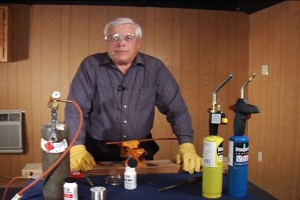Meanwhile, nitrogen, oxygen, and water vapor are all trying to sneak in to the system. The evacuation process evicts these undesirable elements from the neighborhood. Today we will examine the terminology, procedures, and equipment used in the evacuation process.

Terminology
Micron— One thousandth (1/1,000) of a millimeter or 0.00004 of an inch. A micron is a unit of measurement used in measuring a vacuum.Vacuum — The absence of matter in a space. In HVACR terminology, it refers to the absence of air and water vapor within the refrigerant system.
Noncondensables — Gases that will not condense in the condenser.
Dehydrate — To remove water and water vapor from the system.
Evacuation — The removal of water vapor and air from the system.
Procedures
Deep vacuum— Refers to pulling a system down to as low as 20 microns. This method is accomplished by way of a two-stage vacuum pump.Triple evacuation — A method of evacuation that initially pulls the vacuum down to between 1,000 and 2,000 microns. Then a small amount of refrigerant or an inert gas such as nitrogen is introduced into the system. The object is for the gas to absorb moisture from the system. The gas is then purged, and this process is repeated two additional times.
Detecting leaks — Once the system is evacuated, the vacuum pump is valved off. If the system pressure begins to rise according to the micron gauge, there is a leak.
Cleaning — Contaminants form within the system from the mixture of moisture, acid, and oil. This buildup results in sludge. Sludge cannot be removed from the system using a vacuum pump. Standard cleanup procedures using filter-driers should be used.
Equipment
Vacuum pump— The machine at the heart of the evacuation process, the vacuum pump lowers the pressure inside of the system to below atmospheric pressure, causing water vapor to boil off and vent to the atmosphere. The contaminants from the system being evacuated end up in the vacuum pump’s oil. It is necessary to periodically change this oil.Single- and two-stage vacuum pumps are most commonly used in the field today. The two-stage model pulls a deeper vacuum because the first stage exhaust is actually vented into the second stage intake. This allows second stage to pull at a lower pressure, increasing efficiency and reducing the vacuum.
Vacuum pumps are rated in cubic feet per minute (cfm). Three- to 6-cfm pumps are typically used in residential applications.
Refrigerant gauges — In addition to the typical gauge setup, a 3¼8-inch charging hose is connected to the manifold set to allow for faster evacuation.
Electronic vacuum gauge — Sometimes referred to as a micron gauge, the electronic vacuum gauge reads in units of microns, and it is the most accurate method of measuring a vacuum. Some technicians today feel that they know what is sufficient run time for a vacuum pump without connecting a micron gauge. This is a mistake. The professional technician always verifies and measures his or her work with an electronic vacuum gauge. If you do not test, you are only guessing.
Conclusion
Sometime in the future, someone — maybe you — will invent a refrigerant that’s not particularly fussy about its neighbors. Of course, once any element moves in, it not only has to get along with the refrigerant but also other inhabitants, such as thermal expansion valves, metering devices, and controls. So, until then we have the evacuation process to keep the neighborhood in an orderly fashion.For further information on system evacuation, refer to Refrigeration & Air Conditioning Technology, 4th Ed., by William C. Whitman, William M. Johnson, and John A. Tomczyk.
David E. Rothacker is a member of the National Comfort Institute’s Advisory Board and a National Comfort Team Founding Member. For questions or comments on the Tech Page, contact Rothacker at ewizaard@hotmail.com.
Publication date: 06/23/2003



